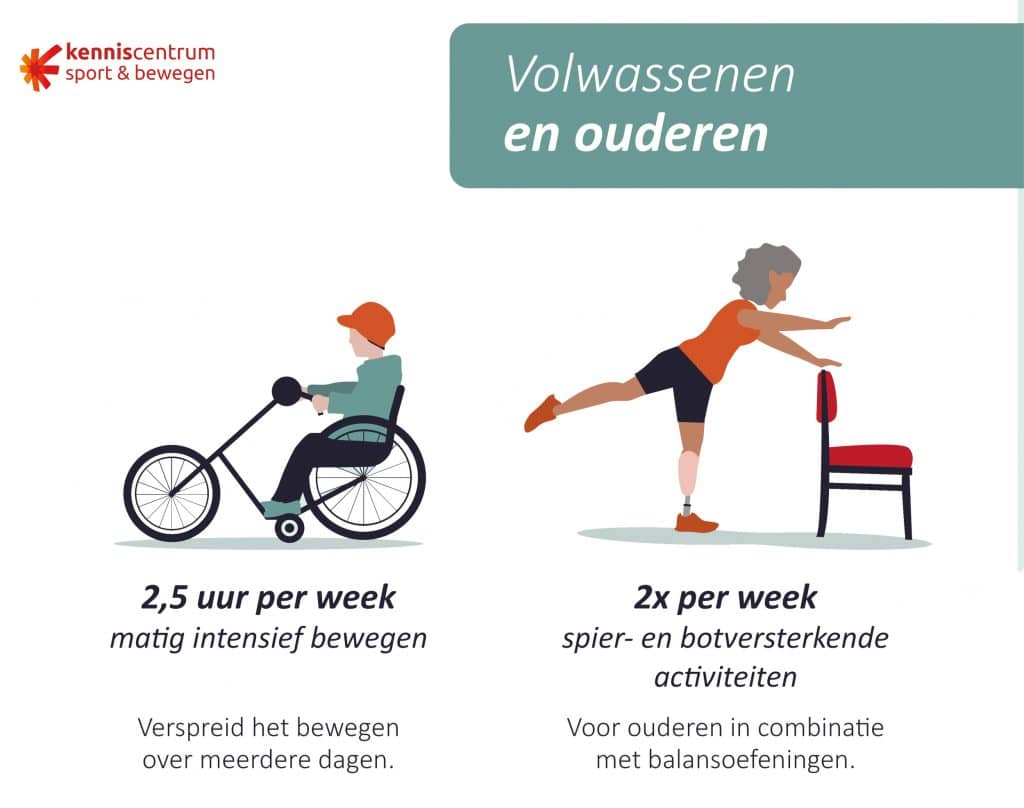Getting enough exercise is important for staying fit and energetic – also for people over 65. Regular exercise reduces the risk of various chronic diseases such as cardiovascular disease, diabetes, and symptoms of depression. Scientific research also shows that older people who exercise regularly have a lower risk of bone fractures than people who do little or no exercise. In this article you can read more about exercise guidelines for people over 65, the importance of bone and muscle strengthening activities and balance exercises.
Exercise guidelines indicate the minimum amount of exercise required to have a positive impact on health. These guidelines have been developed by the Board of Health on the basis of scientific research. The exercise guidelines for people over the age of 65 are set at a minimum of 150 minutes of moderately intense exercise over several days. You can read how you can move moderately intensely in this article. It is also recommended that you do bone and muscle strengthening activities at least twice a week, supplemented with balance exercises. It is recommended to avoid sitting for long periods of time. These numbers act as a guideline, as more frequent, more intense, and/or longer exercise provides more (health) benefits.
Strong bones and muscles and good balance are important
From birth, muscle mass and muscle strength increase. This happens until about the age of 30-35 years. After that, muscle mass gradually decreases by about 1% per year – muscle breakdown is greater than accumulation. The older we get, the greater the decrease in muscle mass. At age 70, this averages around 3-5% annually. A significant loss of muscle mass can lead to a loss of muscle strength and function. So we are talking about sarcopenia. Leukopenia can severely affect the self-reliance of older people, for example because household tasks become more difficult, mobility is reduced, and the risk of falls leading to fractures is increased.[1]. You can read more about sarcopenia in this article.
The older you get, the less coordination between perception and movement. In combination with other risk factors – such as poor eyesight or certain medications – this can increase the risk of falling. Balance exercises train the muscles to keep working together. Good balance ensures that people can keep their balance more easily and fall at a slower speed.
Scientific research shows that doing muscle-strengthening activities twice a week improves muscle strength, endurance, and size. Also at a later age. This can prevent an accelerated breakdown of muscle mass, resulting in less loss of function and people over 65 remaining independent longer.[2,3]. The same principle applies to bone health. Bone density begins to decline from the age of 40. Loading the bones at least twice a week stimulates bone production.
Luc van Loon, Professor of Human Movement Sciences at Maastricht University, explains this in the video below. He also talks about the importance of a high protein diet.
Potential for strengthening muscles and bones and improving balance
Activities to improve muscle tone, strength, endurance and size are called muscle-strengthening activities. This may include strength training or a combination of strength and endurance activities. The activities are to strengthen the bones once there is pressure or impact on the bones. Trauma is best described as carrying shock or trauma to the body or limbs. You can do strength training in the gym, for example, with weights or equipment. A certified fitness center trainer or physical therapist can create a customized program that takes into account individual abilities and limitations.
Balance exercises aim to improve balance while a person is standing or moving. These can be static or dynamic exercises, standing or sitting. Not only specific exercises contribute to balance: Also consider activities such as dancing, Pilates or racquet sports. Examples of exercises include activities that shift body weight and reduce base (small area, feet together, on one foot only), with limited arm support. Balance exercises also reduce the risk of ankle injuries, such as sprains, and help prevent recurrences.
A review study from the UK shows how various sports and exercise activities contribute to stronger bones and muscles or improve balance, as shown in the chart below.[4].
More focus is better, but build it carefully
More intense or longer sessions provide greater profit. It is important to build carefully and to account for reduced load capacity due to age or disturbances. The exercise guidelines recommend performing bone- and muscle-strengthening and balance exercises twice a week. If a demonstrable effect is assumed based on recent research, the required frequency is slightly higher, i.e. two to three times per week.[5].
Tips for strengthening muscle and bone exercises
on the Internet Exercise is a guide to musculoskeletal strengthening activities You’ll find more information about exactly what musculoskeletal-strengthening activities are and what the difference is. Practical exercises for every body part you can do are also done. The exercises are accessible and therefore suitable for anyone who wants to start working on strengthening muscles and bones or wants to maintain accessibility. Is the base good? Then you can proceed to the variations (more complex or more difficult) of the exercises, which can also be found in the exercise guide.
- Cruz-Jentoft, Alfonso J., et al. Sarcopenia: a revised European consensus on definition and prognosis. Age and Aging 48.1 (2019): 16–31
- Dent, Elsa, and others. “International Clinical Practice Guidelines for Sarcopenia (ICFSR): Screening, Diagnosis, and Management.” Journal of Nutrition, Health, and Aging 22.10 (2018): 1148-1161.
- Health Council. (2017). 2017 Exercise Guidelines. Council on Health.
- Foster, Charlie, and Miranda E.G. Armstrong. What types of physical activities are effective in developing musculoskeletal strength and balance?. Journal of Vulnerability, Sarcopenia and Fallacies 3.2 (2018): 58.
- Borde, Ron, Tibor Hortobagi, and Urs Granacher. Dose-response relationships for resistance training in healthy adults: a systematic review and meta-analysis. Sports Medicine 45.12 (2015): 1693-1720.

“Professional reader. Award-winning gamer. Zombie buff. Social media junkie. Bacon maven. Web scholar.”

